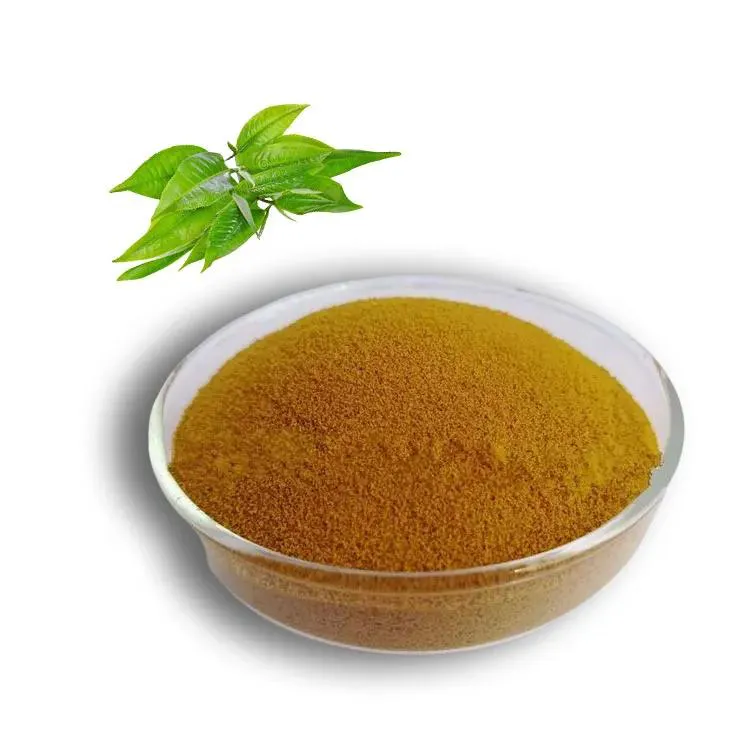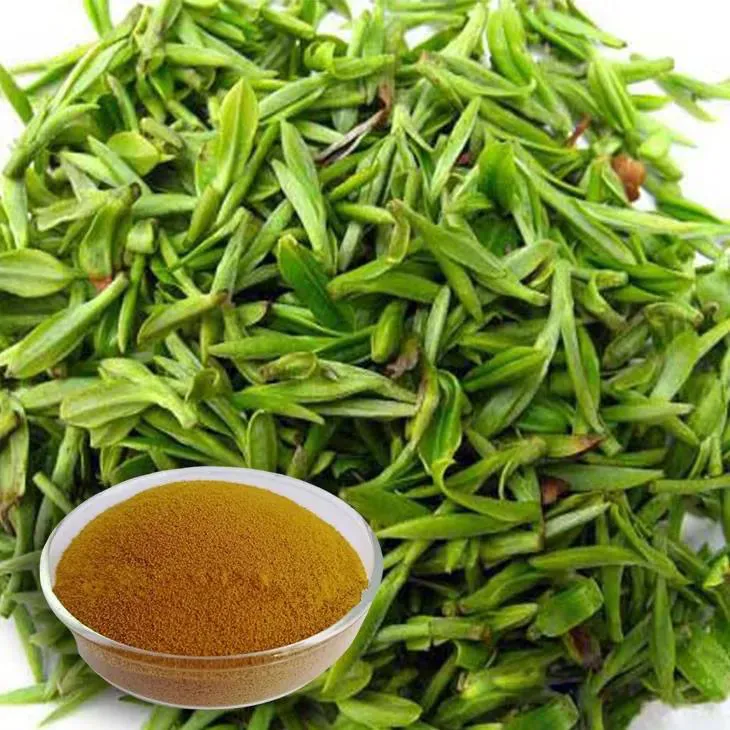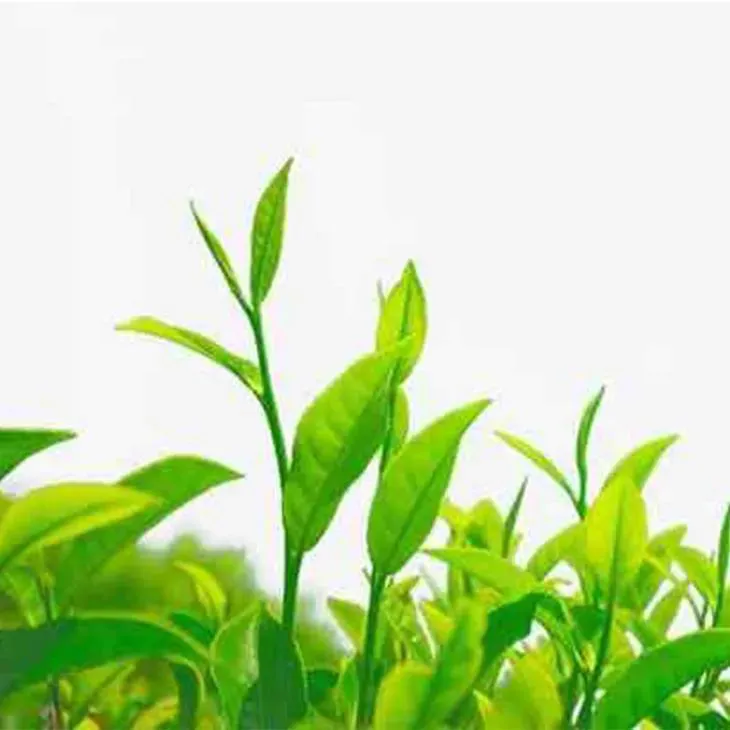- 0086-571-85302990
- sales@greenskybio.com
The extraction process of green tea extract.
2024-11-28

1. Introduction
Green tea has been renowned for its numerous health benefits for centuries. The extraction of Green Tea Extract has become an important process as the extract is rich in valuable compounds that are widely used in various industries, especially the health and beauty industries. The process of extracting Green Tea Extract involves several steps and different methods, each aiming to obtain the maximum amount of beneficial substances while maintaining their quality.

2. Raw Material: Fresh Green Tea Leaves
The quality of the raw material, fresh green tea leaves, plays a crucial role in the final quality of the green tea extract. Green tea leaves are typically harvested from the Camellia sinensis plant. The time of harvest, the variety of the plant, and the growing conditions all influence the composition of the leaves.
2.1 Harvest Time
Young tea leaves are often preferred for extraction as they tend to have a higher concentration of the desired compounds. For example, the first and second flush (new growth periods) of the tea plant usually yield leaves with a rich content of flavonoids and other bioactive substances.
2.2 Tea Plant Variety
Different varieties of Camellia sinensis, such as China type and Assam type, produce leaves with different characteristics. Some varieties may have a higher caffeine content, while others may be richer in certain flavonoids like epigallocatechin gallate (EGCG).
2.3 Growing Conditions
Factors like soil quality, altitude, climate, and sunlight exposure affect the growth of tea plants and the composition of their leaves. Tea plants grown at higher altitudes, for instance, may produce leaves with a more complex flavor profile and potentially higher levels of certain bioactive compounds.

3. Extraction Methods
There are several methods for extracting Green Tea Extract, each with its own advantages and considerations.
3.1 Hot - water Extraction
Hot - water extraction is one of the most common and traditional methods.
-
First, the fresh green tea leaves are carefully cleaned to remove any impurities such as dirt, twigs, and insects. This step is essential to ensure the purity of the extract.
-
The cleaned leaves are then soaked in hot water. The temperature of the water typically ranges from 70 - 90°C. This temperature range is chosen because it helps to dissolve the soluble compounds in the tea leaves effectively without causing excessive degradation of the bioactive substances.
-
The soaking time can vary depending on factors such as the type of tea leaves and the desired concentration of the extract. Generally, it can range from 10 minutes to several hours. During this time, compounds like flavonoids, caffeine, and amino acids are released into the water.
-
After soaking, the resulting liquid, which contains the dissolved compounds, is separated from the remaining solid tea leaves. This can be done through filtration methods such as using a fine - mesh sieve or filter paper.
3.2 Enzymatic Extraction
Enzymatic extraction is a more advanced method that offers certain advantages over hot - water extraction.
-
Similar to hot - water extraction, the green tea leaves are first cleaned thoroughly.
-
Specific enzymes are then added to the tea leaves. These enzymes are carefully selected based on their ability to break down the cell walls of the tea leaves. Commonly used enzymes include cellulases and pectinases. The enzymes work by hydrolyzing the polysaccharides in the cell walls, making it easier for the bioactive compounds inside the cells to be released.
-
The enzyme - treated tea leaves are then incubated at a specific temperature and pH for a certain period of time. The optimal conditions for enzyme activity vary depending on the type of enzyme used. For example, cellulases may work best at a slightly acidic pH and a temperature around 50 - 60°C.
-
After the incubation period, the liquid containing the released compounds is separated from the solid residue, usually through filtration.
3.3 Comparison of Extraction Methods
Hot - water extraction is relatively simple and cost - effective. However, it may not be as efficient in extracting all the bioactive compounds as enzymatic extraction. Enzymatic extraction, on the other hand, can achieve a higher extraction yield and may preserve the integrity of some sensitive compounds better. But it is more complex and requires more precise control of conditions and the use of specialized enzymes, which can increase the cost of the extraction process.

4. Concentration Process
After the extraction step, the resulting liquid extract usually has a relatively low concentration of the desired compounds. Therefore, a concentration process is necessary.
-
One common method of concentration is evaporation. The liquid extract is heated gently under reduced pressure. This allows the water in the extract to evaporate at a lower temperature, which helps to preserve the heat - sensitive compounds. As the water evaporates, the concentration of the bioactive substances in the remaining liquid increases.
-
Another method is membrane filtration. Ultrafiltration or nanofiltration membranes can be used to separate the water from the larger bioactive molecules. This method is more selective and can retain the beneficial compounds while removing the water more efficiently.
5. Drying Process
Once the extract has been concentrated, it needs to be dried to obtain a stable, solid form of the green tea extract.
-
Spray drying is a widely used method. In this process, the concentrated liquid extract is sprayed into a hot air chamber. The hot air rapidly evaporates the remaining water, and the extract is transformed into fine powder particles. Spray drying is favored for its high - speed production and the ability to produce a powder with good flowability and solubility.
-
Vacuum drying is another option. The extract is placed in a vacuum chamber and heated gently. The reduced pressure in the chamber allows the water to be removed at a lower temperature compared to normal drying, which is beneficial for protecting the heat - sensitive components in the extract.
6. Composition and Applications of Green Tea Extract
The green tea extract obtained through the above extraction, concentration, and drying processes is rich in valuable substances.
6.1 Flavonoids
Flavonoids, especially EGCG, are among the most important components in green tea extract. They have been studied for their antioxidant, anti - inflammatory, and anti - cancer properties. In the health industry, products containing green tea extract are often promoted for their potential to boost the immune system, reduce the risk of chronic diseases, and improve overall health.
6.2 Caffeine
Caffeine is a well - known stimulant. In green tea extract, it provides a milder energy boost compared to coffee. In the beauty industry, caffeine - containing green tea extract is sometimes used in products for its ability to reduce puffiness and improve skin tone. In the food and beverage industry, it can be added to energy drinks or functional foods for its stimulant effect.
6.3 Other Compounds
Green tea extract also contains amino acids, such as L - theanine, which has a calming effect and can enhance mental focus. Additionally, there are various polyphenols and minerals in the extract that contribute to its overall health - promoting properties.
7. Conclusion
The extraction process of green tea extract is a multi - step and complex procedure that involves careful selection of raw materials, appropriate extraction methods, and subsequent concentration and drying steps. The resulting green tea extract, rich in valuable substances like flavonoids and caffeine, has a wide range of applications in the health, beauty, and food industries. With the increasing demand for natural and healthy products, the importance of efficient and high - quality green tea extract extraction is likely to continue to grow.
FAQ:
What are the main extraction methods for green tea extract?
The main extraction methods for green tea extract include hot - water extraction and enzymatic extraction. In hot - water extraction, fresh green tea leaves are soaked in hot water to release soluble compounds. Enzymatic extraction utilizes specific enzymes to break down the cell walls of tea leaves, thus achieving better extraction efficiency.
Why is hot - water extraction commonly used for green tea extract?
Hot - water extraction is commonly used because it is a relatively simple and cost - effective method. By soaking the green tea leaves in hot water, many soluble and valuable compounds in the leaves, such as flavonoids and caffeine, can be effectively released.
What are the advantages of enzymatic extraction in green tea extract?
The advantages of enzymatic extraction are mainly reflected in its ability to break down the cell walls of tea leaves more effectively. This allows for better extraction efficiency compared to traditional methods. It can release more of the valuable substances inside the tea leaves, resulting in a higher - quality green tea extract.
What substances are mainly contained in green tea extract?
Green tea extract is mainly rich in flavonoids and caffeine. These substances are highly valued in the health and beauty industries. Flavonoids have antioxidant properties, while caffeine can have a stimulating effect.
Why are concentration and drying processes necessary after extraction?
Concentration and drying processes are necessary after extraction to obtain the final green tea extract in a stable form. Concentration can increase the content of the active substances in the extract, and drying can remove excess moisture, making the extract easier to store, transport, and use.
Related literature
- Green Tea Extract: Production, Composition, and Health Benefits"
- "Advanced Techniques in Green Tea Extract Extraction: A Review"
- "The Role of Green Tea Extract in the Health and Beauty Sectors"
- ▶ Hesperidin
- ▶ Citrus Bioflavonoids
- ▶ Plant Extract
- ▶ lycopene
- ▶ Diosmin
- ▶ Grape seed extract
- ▶ Sea buckthorn Juice Powder
- ▶ Fruit Juice Powder
- ▶ Hops Extract
- ▶ Artichoke Extract
- ▶ Mushroom extract
- ▶ Astaxanthin
- ▶ Green Tea Extract
- ▶ Curcumin
- ▶ Horse Chestnut Extract
- ▶ Other Product
- ▶ Boswellia Serrata Extract
- ▶ Resveratrol
- ▶ Marigold Extract
- ▶ Grape Leaf Extract
- ▶ New Product
- ▶ Aminolevulinic acid
- ▶ Cranberry Extract
- ▶ Red Yeast Rice
- ▶ Red Wine Extract
-
Apricot Powder
2024-11-28
-
Scutellaria Extract
2024-11-28
-
Berberis aristata Extract
2024-11-28
-
Ivy Extract
2024-11-28
-
Okra Extract
2024-11-28
-
Alfalfa Meal
2024-11-28
-
Acerola Juice Powder
2024-11-28
-
Saffron Extract Powder
2024-11-28
-
Panax Ginseng Leaf Extract
2024-11-28
-
Black Pepper Extract
2024-11-28





















